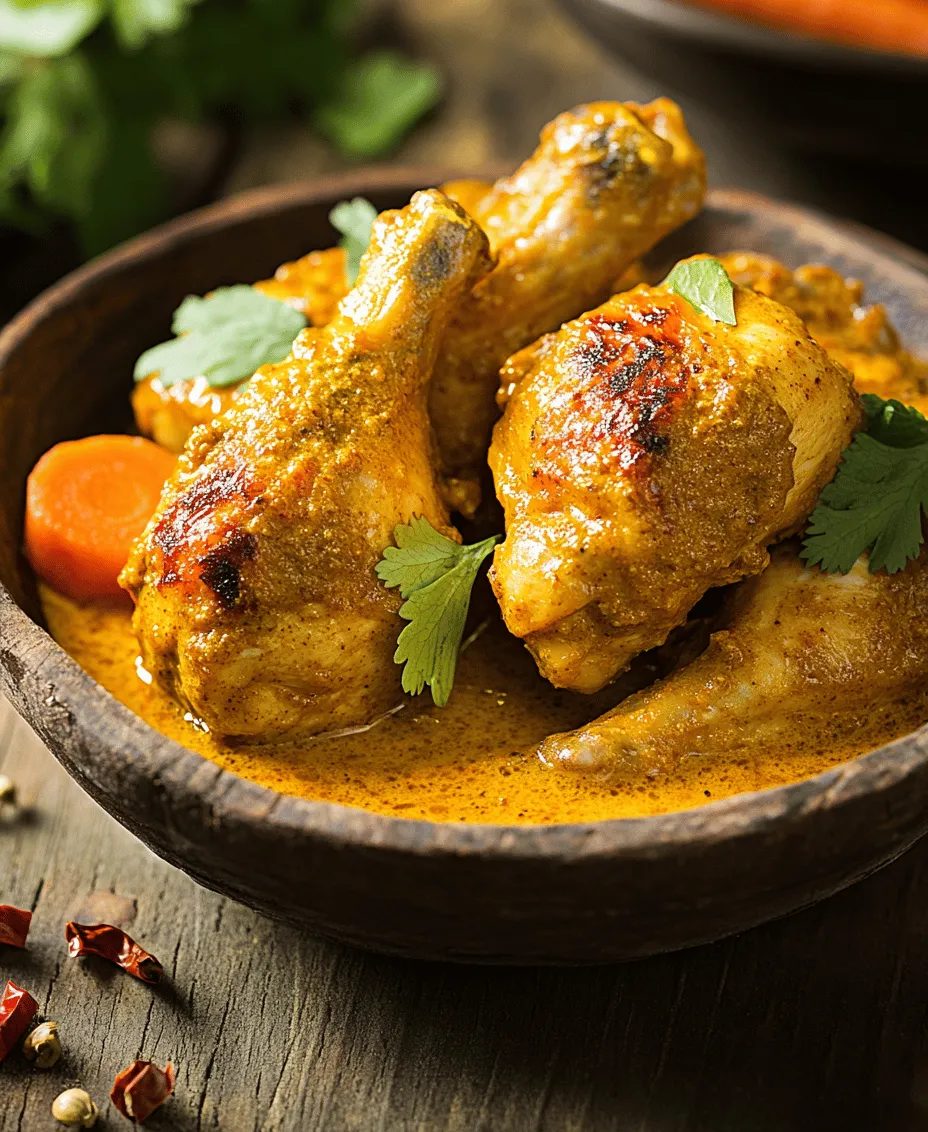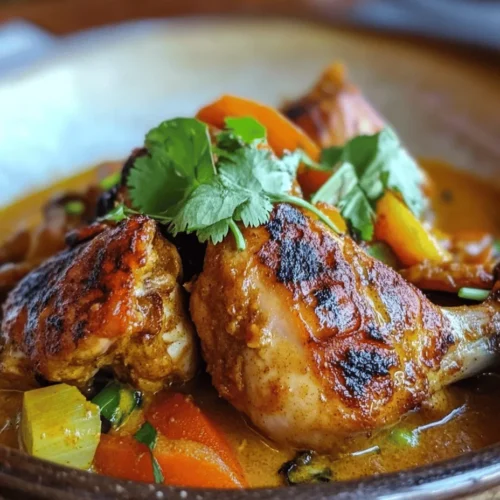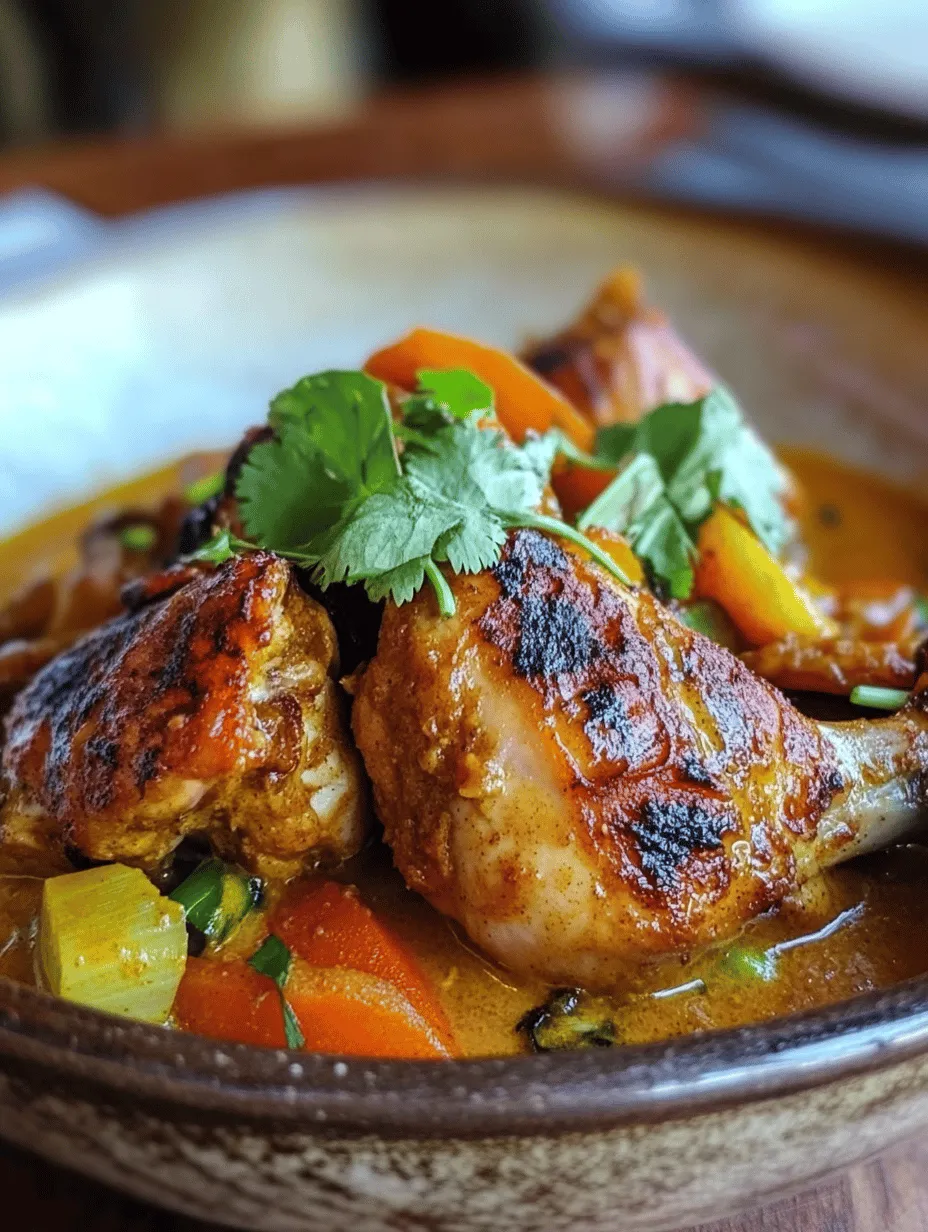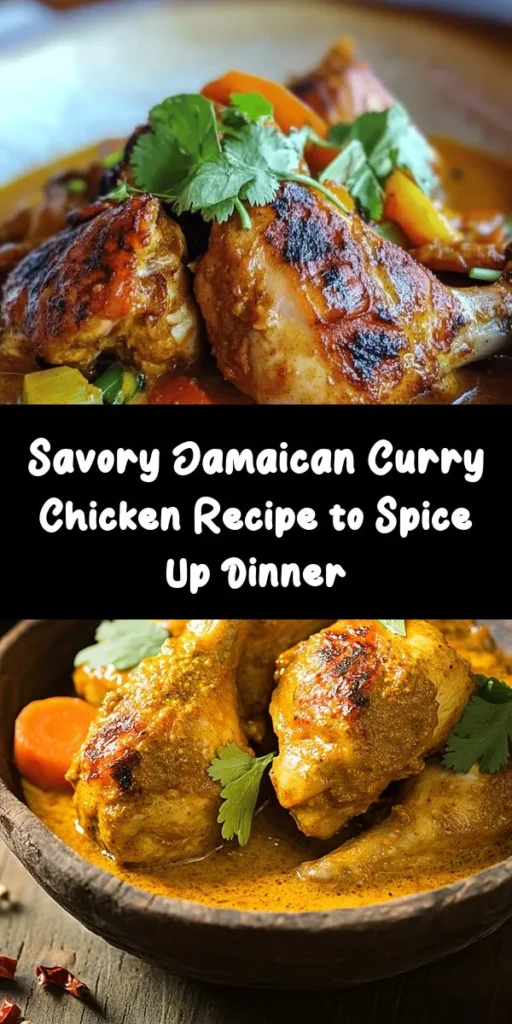Explore the rich and vibrant flavors of Jamaican cuisine with this Authentic Jamaican Curry Chicken recipe. Known for its aromatic spices and comforting textures, this dish is a staple in many Caribbean households. The origins of Jamaican curry chicken can be traced back to the island’s diverse culinary history, which reflects the fusion of indigenous Taino, African, Indian, and British influences. Each of these cultures has contributed unique flavors and cooking techniques, culminating in the delicious and hearty dish we enjoy today.
The significance of Jamaican curry chicken goes beyond mere sustenance; it embodies the warmth and hospitality of Jamaican culture. Traditionally enjoyed during family gatherings and celebrations, this comforting dish is often served alongside rice and peas or dumplings, creating a complete meal that brings people together. In this article, we will delve into the origins of Jamaican curry chicken, the significance of its ingredients, and provide you with a step-by-step guide to creating this delicious meal that is sure to impress family and friends.
Understanding Jamaican Cuisine
The Influence of Caribbean Flavors
Caribbean culinary traditions are a vibrant tapestry of flavors that reflect the region’s rich history and cultural diversity. Each island boasts its unique culinary practices, but they often share common elements, such as the use of fresh herbs, bold spices, and locally sourced ingredients. Jamaican cuisine, in particular, is renowned for its robust flavors and aromatic dishes, with curry chicken being a quintessential example.
Spices play a pivotal role in Jamaican cooking, with many dishes showcasing the island’s famed spice blends. Jamaican curry powder, often a combination of turmeric, cumin, coriander, and fenugreek, is essential for achieving the distinct flavor profile associated with this cuisine. The historical context of curry in Jamaica is fascinating; while curry originated in India, it was brought to the Caribbean by Indian laborers in the 19th century. Over time, Jamaicans adapted this cooking style, infusing it with local ingredients and flavors, resulting in a unique interpretation of curry that is spicy, aromatic, and deeply satisfying.
Key Ingredients in Jamaican Curry Chicken
Importance of Jamaican Curry Powder
At the heart of any authentic Jamaican curry dish is Jamaican curry powder. Unlike generic curry powders found in other cuisines, Jamaican curry powder is characterized by its earthy, warm flavors and vibrant yellow hue, primarily derived from turmeric. It typically contains a blend of spices, including cumin, coriander, fenugreek, and allspice, which contribute to its complex flavor profile. This unique blend not only enhances the taste of the chicken but also adds a beautiful color to the dish.
The Role of Scotch Bonnet Peppers
Another key ingredient that elevates Jamaican curry chicken is the Scotch bonnet pepper. Known for its fruity flavor and intense heat, the Scotch bonnet is a staple in Jamaican cooking. It delivers a fiery kick that is balanced by the other flavors in the dish, making it a beloved component in many Caribbean recipes. If you prefer a milder flavor, you can adjust the quantity of Scotch bonnet used or even substitute it with another milder pepper, though you may lose some authenticity.
Benefits of Coconut Milk
Coconut milk is another essential ingredient that contributes to the richness and creaminess of Jamaican curry chicken. It creates a luscious sauce that coats the chicken and vegetables, enhancing the overall flavor of the dish. Additionally, coconut milk helps to balance the heat from the spices and peppers, creating a harmonious blend of flavors that is comforting and satisfying.
Ingredients Breakdown
Chicken Selection
When preparing Jamaican curry chicken, the choice of chicken is crucial for achieving the best flavor and texture. Typically, bone-in cuts are preferred, as they provide more flavor and moisture during cooking. Bone-in thighs or drumsticks are excellent choices, as they remain tender and juicy even after prolonged cooking. However, if you prefer a quicker cooking time, boneless chicken breasts can also be used, though they may not yield the same depth of flavor.
Each cut has its pros and cons. Bone-in chicken tends to be more flavorful but requires longer cooking times. In contrast, boneless cuts cook quickly but may be slightly less juicy. Choose according to your time constraints and flavor preferences.
Spice Profile
The spice profile of Jamaican curry chicken is essential for achieving the authentic taste of this dish. Jamaican curry powder is the primary spice blend, providing a warm and aromatic base. To enhance the flavor further, allspice is often added, which contributes a unique sweetness and complexity. Allspice, known as “pimento” in Jamaica, is a staple spice in many Caribbean dishes and is prized for its versatility.
For those who enjoy a bit more heat, cayenne pepper can be introduced to the mix. However, it’s important to adjust the spice levels according to your personal preference. Start with a small amount and gradually increase it, tasting as you go to achieve the desired level of heat.
Aromatics and Vegetables
Aromatic ingredients play a significant role in the flavor development of Jamaican curry chicken. Onions, garlic, and ginger are commonly used to build a flavorful base. When sautéed, these aromatics release their natural oils and essences, infusing the dish with a rich depth of flavor.
Adding vegetables such as carrots and green onions not only enhances the dish’s color and texture but also contributes additional nutrients. Carrots provide a subtle sweetness that balances the spices, while green onions add a fresh, crisp element that brightens the overall dish.
Liquid Components
The liquid components in Jamaican curry chicken are crucial for creating a flavorful sauce that envelops the chicken and vegetables. Chicken broth is often used to provide depth of flavor, while coconut milk serves as the creamy base. The combination of these liquids results in a rich, hearty sauce that perfectly complements the spices and aromatics.
Using a quality chicken broth is recommended, as it will significantly impact the overall flavor of the dish. Homemade broth is ideal, but store-bought options can also work well in a pinch. Coconut milk adds creaminess and richness, making each bite indulgent and satisfying.
Step-by-Step Cooking Instructions
Marinating the Chicken
The first step in creating an authentic Jamaican curry chicken is marinating the chicken. This process is essential for flavor infusion, as it allows the spices and seasonings to penetrate the meat, resulting in a more flavorful dish. To marinate the chicken, combine it with Jamaican curry powder, minced garlic, ginger, salt, and a splash of vinegar or lime juice. The acidity from the vinegar or lime juice helps to tenderize the meat while enhancing the flavors.
For optimal flavor, it is recommended to marinate the chicken for at least 1 hour, though overnight marination will yield the best results. Ensure that the chicken is well-coated with the marinade and stored in the refrigerator until you are ready to cook.
Sautéing the Aromatics
Once the chicken has marinated, the next step is to sauté the aromatics. Heat a generous amount of oil in a large pot or Dutch oven over medium heat. The oil should be hot but not smoking; this is crucial for achieving that beautiful golden-brown color on the onions and garlic.
Add chopped onions and sauté until they become translucent and fragrant, about 5 minutes. Next, add minced garlic and ginger, stirring constantly to prevent burning. This technique allows the flavors to meld and intensify, forming a solid flavor base for the curry. Once the aromatics are cooked to perfection, it’s time to add the marinated chicken to the pot, allowing it to sear and develop a lovely brown crust.
As you continue to follow the cooking instructions and build on the flavors, you will be well on your way to creating a delicious and authentic Jamaican curry chicken that captures the essence of Caribbean cuisine. Stay tuned for the next part of this article, where we will explore the remaining cooking steps and tips for serving this exquisite dish!

Why Aromatics are Essential for Building Flavor
Aromatics play a crucial role in cooking, especially in dishes like Jamaican Curry Chicken. They form the foundation of flavor that elevates your dish from ordinary to extraordinary. Aromatics such as onions, garlic, ginger, and bell peppers release their essential oils when cooked, creating a fragrant base that enhances the overall taste profile of the curry.
In Jamaican cuisine, the combination of these aromatics with curry powder and other spices creates a complex flavor that is both savory and aromatic. The process of sautéing these ingredients helps to develop depth, ensuring that each bite is packed with flavor. When preparing Jamaican Curry Chicken, take the time to properly sauté your aromatics until they are soft and fragrant; this step is essential for a well-rounded dish.
Browning the Chicken
The Maillard Reaction: Why Browning Matters
Browning the chicken is a fundamental step in preparing Jamaican Curry Chicken. This process, known as the Maillard reaction, occurs when proteins and sugars in the chicken interact under high heat, resulting in complex flavors and a rich, golden color. Browning not only enhances the visual appeal of the dish but also adds layers of flavor that will permeate the entire curry.
To achieve the perfect browning, use a heavy-bottomed pot or Dutch oven that retains heat well. Preheat the pot before adding oil, ensuring the chicken sizzles upon contact. This technique locks in moisture and creates a beautiful crust. Avoid overcrowding the pot; instead, brown the chicken in batches if necessary to maintain even cooking and browning.
Tips for Browning Chicken Evenly
1. Pat Dry: Before browning, pat the chicken pieces dry using paper towels. Removing excess moisture helps achieve better browning.
2. Use High Heat: Start with medium-high heat to sear the chicken. Once browned, you can lower the heat to prevent burning.
3. Allow Space: Leave enough space between chicken pieces. Overcrowding creates steam, resulting in uneven browning.
4. Do Not Rush: Let the chicken sit undisturbed in the pot for a few minutes before flipping. This allows the crust to form properly.
Adding Vegetables for Texture and Flavor
Incorporating vegetables into your Jamaican Curry Chicken not only enriches the dish but also adds texture and color. Vegetables like bell peppers, carrots, and potatoes absorb the spices and contribute their own flavors, creating a more balanced meal.
How Vegetables Contribute to the Overall Dish
Adding vegetables enhances the nutritional value of your curry while providing a pleasing contrast to the tender chicken. The sweetness of bell peppers and the earthiness of potatoes complement the spiciness of the curry, rounding out the dish. Additionally, vegetables provide a delightful crunch that contrasts with the softness of the chicken.
Timing for Adding Ingredients to Maintain Texture
To maintain the ideal texture of vegetables, timing is key. Add heartier vegetables, such as carrots and potatoes, early in the cooking process so they have time to soften. Softer vegetables, like bell peppers, should be added later to ensure they retain some of their crunch. A good rule of thumb is to add sturdier vegetables after the chicken has browned, allowing them to cook for about 10-15 minutes before adding quick-cooking ingredients.
Simmering to Perfection
Simmering is a crucial step in ensuring your chicken is tender and infused with flavor. The gentle cooking method allows the chicken to absorb the spices fully while becoming juicy and tender.
The Science Behind Simmering for Tender Chicken
Simmering works by cooking the chicken at a low temperature, which helps break down the proteins and connective tissues. This method prevents the meat from becoming tough and dry, ensuring a deliciously tender result. As the curry simmers, the flavors meld together, creating a harmonious dish.
Adjusting Cooking Times Based on Chicken Size
When simmering, consider the size of your chicken pieces. Generally, bone-in pieces take longer to cook than boneless ones. A good guideline is to simmer bone-in chicken for about 30-40 minutes and boneless chicken for 20-30 minutes, checking for doneness. The chicken is ready when it reaches an internal temperature of 165°F (75°C) and is tender enough to shred easily with a fork.
Final Seasoning Adjustments
Once your Jamaican Curry Chicken has simmered to perfection, it’s time for the final touches. This step is essential to ensure the dish is well-balanced and bursting with flavor.
How to Taste and Adjust Seasoning Effectively
Before serving, taste the curry and adjust the seasoning as needed. You might want to add more salt, pepper, or a splash of lime juice for brightness. Balancing flavors is about finding the right combination that suits your palate. If the curry is too spicy, adding a splash of coconut milk can help mellow the heat.
Techniques for Thickening the Sauce if Desired
If you prefer a thicker sauce, there are several techniques to achieve this. You can let the curry simmer uncovered for a few more minutes to reduce the sauce. Alternatively, you can mix a tablespoon of cornstarch with water to create a slurry and stir it into the curry, allowing it to thicken. For a richer flavor, consider blending a portion of the cooked vegetables into the sauce before serving.
Serving Suggestions
Jamaican Curry Chicken is a versatile dish that pairs beautifully with various sides, enhancing your dining experience.
Traditional Pairings: Rice and Peas, White Rice, or Roti
The most traditional pairing is rice and peas, which is a staple in Jamaican cuisine. The creaminess of coconut milk used in the rice complements the spices in the curry. Alternatively, white rice serves as a neutral backdrop, allowing the flavors of the curry to shine. Roti, a type of flatbread, is also an excellent choice for scooping up the delicious sauce.
Creative Presentation Ideas for Serving
To elevate your serving presentation, consider garnishing your Jamaican Curry Chicken with fresh cilantro or scallions. Serve it in a large, colorful dish to showcase the vibrant colors of the curry and vegetables. Accompanying your meal with a fresh salad or a side of fried plantains can add variety and enhance the overall dining experience.
Nutritional Information
Understanding the nutritional content of your dish can guide your dietary choices and highlight its health benefits.
Caloric Breakdown
A typical serving of Jamaican Curry Chicken contains approximately 400-500 calories, depending on the portion size and additional ingredients. This dish is packed with protein from the chicken and healthy fats from coconut milk, making it satisfying and nutritious.
Nutritional Benefits of Key Ingredients
Key ingredients in Jamaican Curry Chicken, such as chicken, coconut milk, and spices, offer numerous health benefits. Chicken is a great source of lean protein, essential for muscle building and repair. Coconut milk provides healthy fats and can improve heart health. Spices like turmeric and ginger not only enhance flavor but also possess anti-inflammatory properties.
Health Considerations
When preparing Jamaican Curry Chicken, it’s essential to consider potential dietary restrictions and adaptations.
Potential Dietary Restrictions and Adaptations
For those with gluten intolerance, this recipe is naturally gluten-free. To accommodate dairy-free diets, ensure that all ingredients are free from dairy. If you’re looking to reduce calories, consider using skinless chicken or replacing some coconut milk with low-sodium chicken broth.
The Health Benefits of Coconut Milk and Spices
Coconut milk is rich in medium-chain triglycerides (MCTs), which may help with weight management and provide quick energy. The spices commonly used in Jamaican cuisine, such as curry powder, cumin, and allspice, are not only flavorful but also packed with antioxidants that promote overall health.
Cultural Significance of Jamaican Curry Chicken
Jamaican Curry Chicken is much more than a meal; it is a dish steeped in culture and tradition, often served during family gatherings and celebrations.
Family and Festivity
In Jamaican culture, food plays a vital role in bringing people together. Jamaican Curry Chicken is often a centerpiece at family events, holidays, and gatherings, symbolizing hospitality and warmth. The shared experience of enjoying a delicious meal fosters connections and creates lasting memories.
Personal Anecdotes or Stories Related to the Dish
Many Jamaicans have fond memories of gathering around the table to share a hearty meal of curry chicken, often accompanied by laughter and storytelling. These moments highlight the importance of food in building and maintaining family relationships, making Jamaican Curry Chicken a beloved dish across generations.
Variations Across the Caribbean
While Jamaican Curry Chicken has its unique flavor profile, variations can be found throughout the Caribbean. Each island may incorporate local ingredients and spices, leading to distinct adaptations. For example, Trinidadian curry chicken often features a different blend of spices and may include the use of chickpeas, while Barbadian versions might incorporate sweet potatoes or different cooking techniques.
Conclusion: Embracing the Flavors of Jamaica
Authentic Jamaican Curry Chicken is not just a dish; it is a celebration of culture, tradition, and flavor. By understanding the ingredients and mastering the cooking techniques outlined here, you can create a culinary experience that transports you to the vibrant islands of Jamaica. Whether enjoyed at a family gathering or a quiet dinner at home, this dish is sure to delight and satisfy, inviting everyone to savor the rich culinary heritage of the Caribbean. Embrace the flavors of Jamaica and let this dish be a part of your family’s culinary journey.



